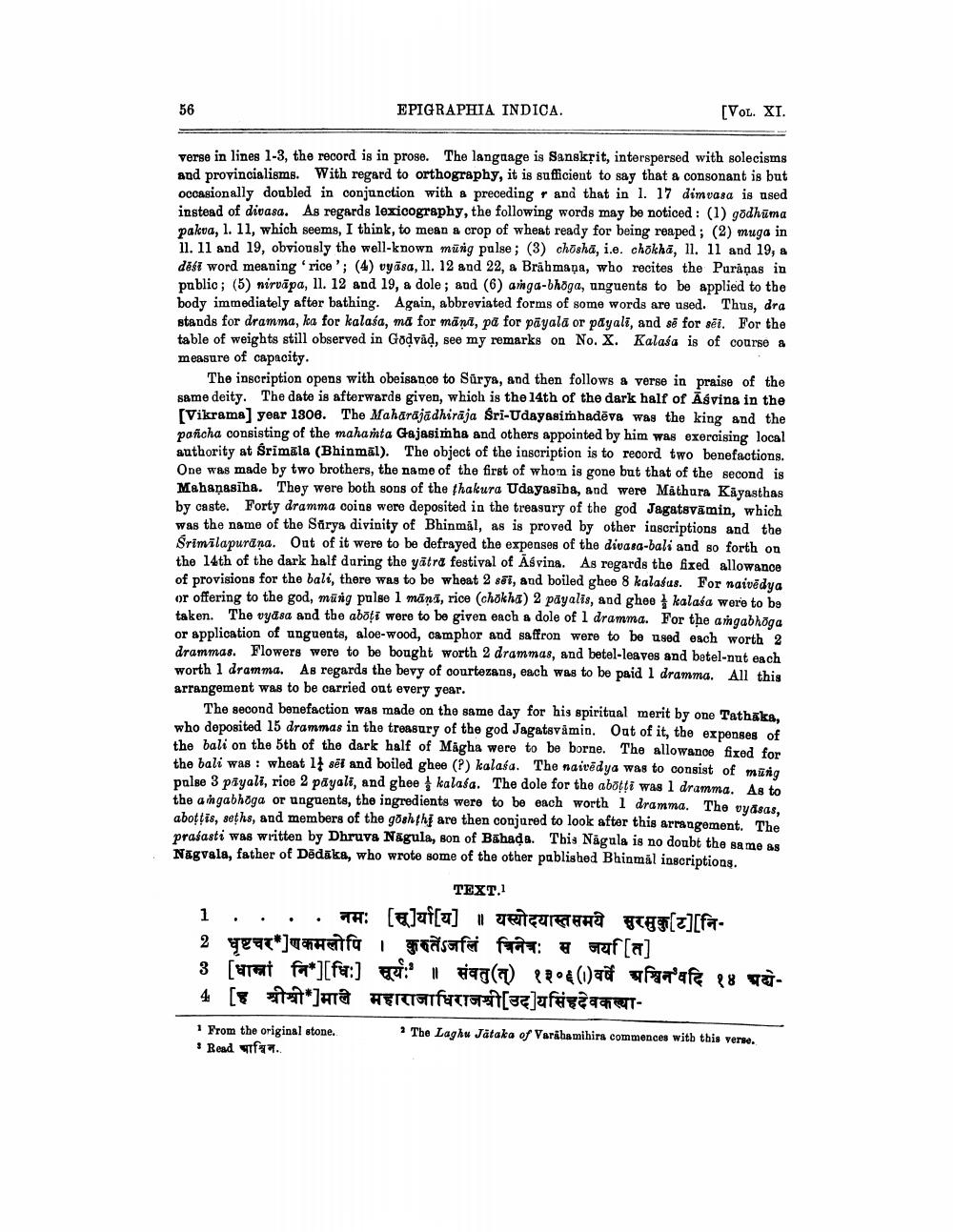________________
EPIGRAPHIA INDICA.
[VOL. XI.
verse in lines 1-3, the record is in prose. The language is Sanskrit, interspersed with solecisms and provincialisms. With regard to orthography, it is sufficient to say that a consonant is but occasionally doubled in conjunction with a preceding r and that in 1. 17 dimvasa is ased instead of divasa. As regards lexicography, the following words may be noticed : (1) godhūma pakua, 1. 11, which seems, I think, to mean a crop of wheat ready for being reaped ; (2) muga in 11. 11 and 19, obviously the well-known mūng palse; (3) chosha, i.e. chokhā, 11. 11 and 19, a dafi word meaning rice'; (4) vyāsa, 11. 12 and 22, a Brahmapa, who recites the Puranas in public ; (5) nirvāpa, 11. 12 and 19, a dole; and (6) anga-bhoga, unguents to be applied to the body immediately after bathing. Again, abbreviated forms of some words are used. Thus, dra stands for dramma, ka for kalasa, ma for mānī, på for pāyala or payali, and së for sēi. For the table of weights still observed in Godvád, see my remarks on No. X. Kalaba is of course & measure of capacity.
The inscription opens with obeisance to Sūrys, and then follows a verse in praise of the some deity. The date is afterwards given, which is the 14th of the dark half of Āgvina in the [Vikrama) year 1806. The Maharajadhiraja Šri-Udayasimhadēva was the king and the pañcha consisting of the mahanta Gajasimha and others appointed by him was exercising local authority at Srimala (Bhinmal). The object of the inscription is to record two benefactions. One was made by two brothers, the name of the first of whom is gone but that of the second is Mahanasiha. They were both sons of the thakura Udayasiba, and were Mathura Kiyasthas by caste. Forty dramma coins were deposited in the treasury of the god Jagatsvāmin, which was the name of the Sürya divinity of Bhinmal, as is proved by other inscriptions and the Srimilapurdna. Out of it were to be defrayed the expenses of the divasa-bali and so forth on the 14th of the dark half during the yātra festival of Asvins. As regards the fixed allowance of provisions for the bali, there was to be wheat 2 szi, and boiled ghee 8 kalafus. For naivedya or offering to the god, mūng pulse 1 mänī, rice (chokha) 2 payalis, and ghee kalasa were to be taken. The vyasa and the abofi were to be given each a dole of 1 dramma. For the angabhöga or application of unguente, aloe-wood, camphor and saffron were to be used each worth 2 drammas. Flowers were to be bought worth 2 drammas, and betel-leaves and betel nut each worth 1 dramma. As regards the bevy of courtezans, each was to be paid 1 dramma. All this arrangement was to be carried out every year.
The second benefaction was made on the same day for his spiritual merit by one Tathaka, who doposited 15 drammas in the treasury of the god Jagatsvåmin. Out of it, the expenses of the bali on the 5th of the dark half of Magha were to be borne. The allowance fixed for the bali was : wheat 14 sēl and boiled ghee (?) kalasa. The naivedya was to consist of mūng pulse 3 payali, rice 2 pāyali, and ghee kalasa. The dole for the abotti was 1 dramma. As to the a ingabhöga or unguents, the ingredients were to be each worth 1 dramma. Tho vyasas. aboţtis, saths, and members of the goshthi are then conjured to look after this arrangement. The prasasti was written by Dhruva Nagula, son of Bāhada. This Nägula is no doubt the same as Nagvala, father of Dēdaka, who wrote some of the other published Bhinmal inscriptions.
TEXT. 1 . ... TH: [Ejuf[u] | Jeigur yu[z][fa2 yet*]Thaifu | Fasafi frau: gruf[a] 3 urat fa*][fu:] : l a polla alaf 8 ya 4 [ nt*]ata HETETUTTopan[az]ufurah
1 From the original stone. * Read .
2 The Laghu Jätaka of Varahamihira commences with this verke.




